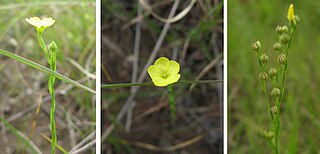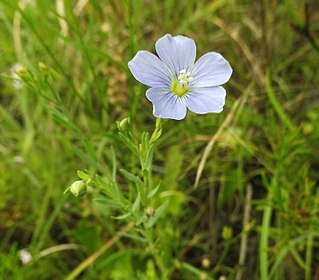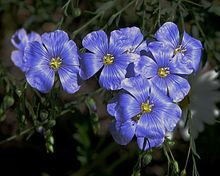
Flax, also known as common flax or linseed, is a flowering plant, Linum usitatissimum, in the family Linaceae. It is cultivated as a food and fiber crop in regions of the world with temperate climates. Textiles made from flax are known in English as linen and are traditionally used for bed sheets, underclothes, and table linen. Its oil is known as linseed oil. In addition to referring to the plant, the word "flax" may refer to the unspun fibers of the flax plant. The plant species is known only as a cultivated plant and appears to have been domesticated just once from the wild species Linum bienne, called pale flax. The plants called "flax" in New Zealand are, by contrast, members of the genus Phormium.

Linum bienne, the pale or narrowleaf flax, is a flowering plant in the genus Linum, native to the Mediterranean region and western Europe, north to England and Ireland.

Linaceae is a family of flowering plants. The family is cosmopolitan, and includes about 250 species in 14 genera, classified into two subfamilies: the Linoideae and Hugonioideae. Leaves of the Linaceae are always simple; arrangement varies from alternate to opposite or whorled. The hermaphroditic, actinomorphic flowers are pentameric or, very rarely, tetrameric.
Flax is a plant cultivated for food and fiber in cooler regions of the world.

Glaucium is a genus of about 25 species of annual, biennial or perennial herbaceous flowering plants in the family Papaveraceae, native to Europe, north Africa, and southwest and central Asia. The species commonly occur in saline habitats, including coasts and salt pans.

Linum lewisii is a perennial plant in the family Linaceae, native to western North America from Alaska south to Baja California, and from the Pacific Coast east to the Mississippi River. It grows on ridges and dry slopes, from sea level in the north up to 11,000 feet in the Sierra Nevada.

Linum perenne, the perennial flax, blue flax or lint, is a flowering plant in the family Linaceae, native to Europe, primarily in the Alps and locally in England. It has been introduced into North America, where it can be found on mountain ridges, wooded areas, and in sandy plain habitats of the sagebrush steppe, growing near sagebrush and rabbitbrush (Chrysothamnus).
Blue flax is a common name of several species in the genus Linum (flax):

Hymenosporum is a monotypic genus in the family Pittosporaceae. The sole included species is Hymenosporum flavum, commonly known as native frangipani, which is a rainforest tree native to New Guinea, Queensland and New South Wales. Despite its common name, it is not closely related to the frangipani, but is related to the widespread genus Pittosporum.

Linum grandiflorum is a species of flax known by several common names, including flowering flax, red flax, scarlet flax, and crimson flax. It is native to Algeria, but it is known elsewhere in Northern Africa, Southern Europe and in several locations in North America as an introduced species. It is an annual herb producing an erect, branching stem lined with waxy, lance-shaped leaves 1 to 2 centimeters long. The inflorescence bears flowers on pedicels several centimeters long. The flower has 5 red petals each up to 3 centimeters long and stamens tipped with anthers bearing light blue pollen. It can on occasion be found as a casual well outside its normal established range; records from the British Isles, for example, are reasonably frequent but, grown as an annual, it rarely persists for more than one season.

Linum medium, common name stiff yellow flax, is a species of Linum (flax) native to eastern North America. It is found as far west as Texas and Wisconsin, east to the Atlantic ocean, north to Ontario and Maine, and south to southern Florida. It is also found in The Bahamas.

Linum narbonense, the perennial flax or blue flax, is a flowering plant in the family Linaceae, native to Europe and similar in appearance to Linum perenne.
Flavum is a Latin word meaning "yellow". It is often used in taxonomy for species names typically in scientific names for animals and plants to refer to the flower colour or other aspect of the species.

Linum flavum, the golden flax or yellow flax, is a species of flowering plant in the family Linaceae, native to central and southern Europe. It is an erect, woody perennial growing to 30 cm (12 in) tall by 20 cm (8 in) broad, with dark green, semi-evergreen leaves, and terminal clusters of bright yellow, five-petalled flowers in spring. The Latin flavum means "pure yellow".
Golden flax is a common name for several plants in the flax family (Linaceae), and may refer to:

Linum pratense, commonly called meadow flax, is a species of flowering plant in the flax family (Linaceae). It is native to the United States, where it is found in the south-central and southwestern regions of the country. Its natural habitat is in dry, open prairies over calcareous or sandy soil. It can be found in both intact and disturbed communities.

Linum monogynum, the rauhuia or New Zealand linen flax, is a species of flowering plant in the family Linaceae, which is endemic to New Zealand. It is a low-growing short-lived perennial or woody subshrub, growing up to 16 in (41 cm) tall. Its spear-shaped, leathery-gray to green leaves are 0.2–1 inches (5–25 mm) long. Its pretty white flowers are up to 1 in (2.5 cm) in diameter, and have five overlapping petals. It is monoecious, having both male and female organs on one plant.















